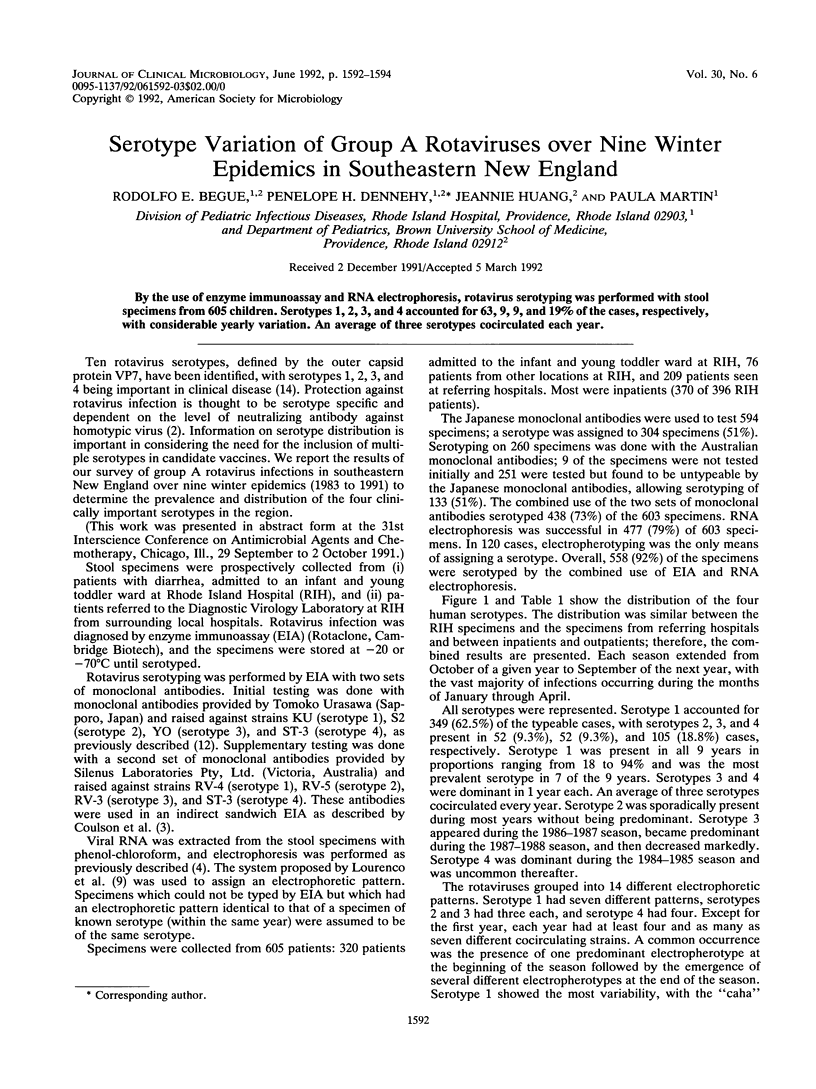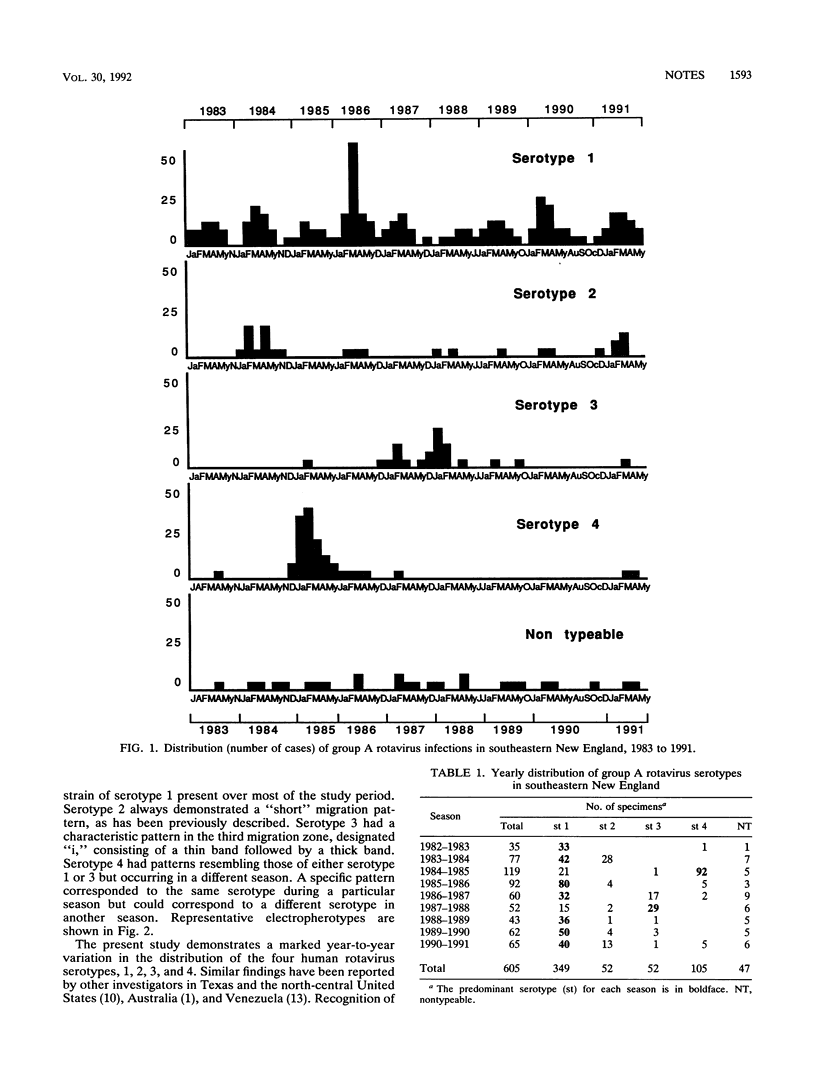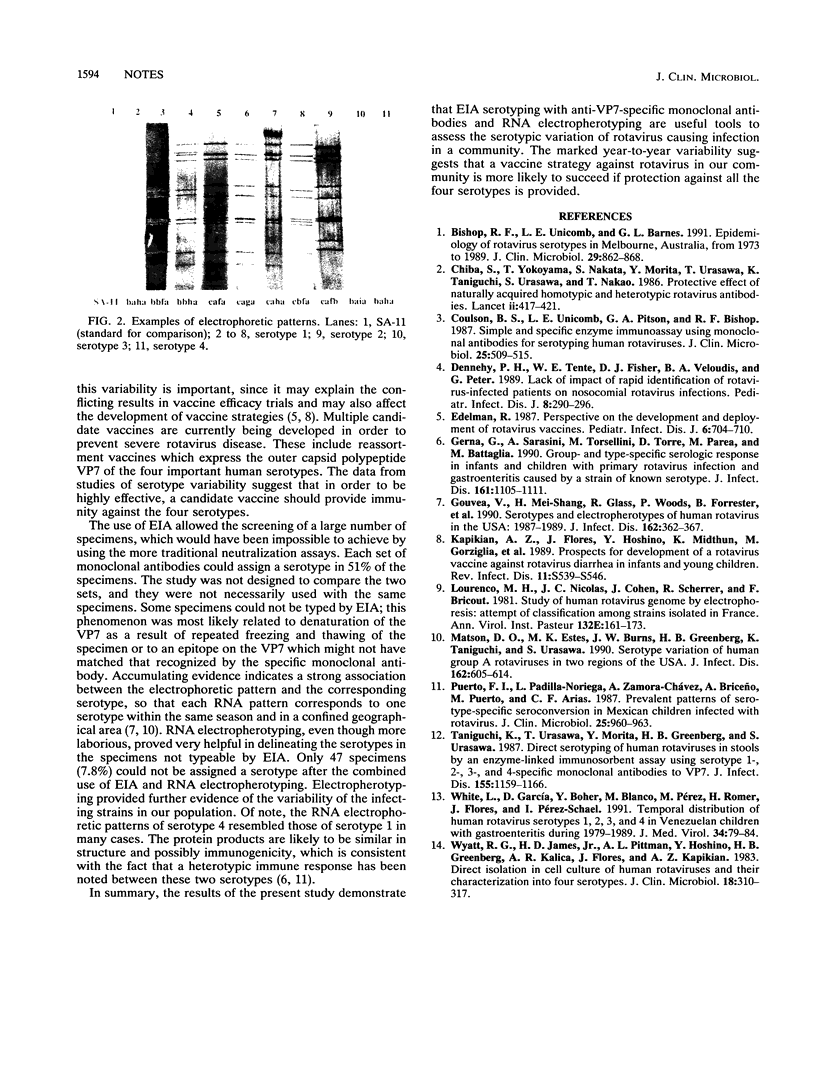Abstract
By the use of enzyme immunoassay and RNA electrophoresis, rotavirus serotyping was performed with stool specimens from 605 children. Serotypes 1, 2, 3, and 4 accounted for 63, 9, 9, and 19% of the cases, respectively, with considerable yearly variation. An average of three serotypes cocirculated each year.
Full text
PDF


Images in this article
Selected References
These references are in PubMed. This may not be the complete list of references from this article.
- Bishop R. F., Unicomb L. E., Barnes G. L. Epidemiology of rotavirus serotypes in Melbourne, Australia, from 1973 to 1989. J Clin Microbiol. 1991 May;29(5):862–868. doi: 10.1128/jcm.29.5.862-868.1991. [DOI] [PMC free article] [PubMed] [Google Scholar]
- Chiba S., Yokoyama T., Nakata S., Morita Y., Urasawa T., Taniguchi K., Urasawa S., Nakao T. Protective effect of naturally acquired homotypic and heterotypic rotavirus antibodies. Lancet. 1986 Aug 23;2(8504):417–421. doi: 10.1016/s0140-6736(86)92133-1. [DOI] [PubMed] [Google Scholar]
- Coulson B. S., Unicomb L. E., Pitson G. A., Bishop R. F. Simple and specific enzyme immunoassay using monoclonal antibodies for serotyping human rotaviruses. J Clin Microbiol. 1987 Mar;25(3):509–515. doi: 10.1128/jcm.25.3.509-515.1987. [DOI] [PMC free article] [PubMed] [Google Scholar]
- Dennehy P. H., Tente W. E., Fisher D. J., Veloudis B. A., Peter G. Lack of impact of rapid identification of rotavirus-infected patients on nosocomial rotavirus infections. Pediatr Infect Dis J. 1989 May;8(5):290–296. [PubMed] [Google Scholar]
- Edelman R. Perspective on the development and deployment of rotavirus vaccines. Pediatr Infect Dis J. 1987 Aug;6(8):704–710. doi: 10.1097/00006454-198708000-00002. [DOI] [PubMed] [Google Scholar]
- Gerna G., Sarasini A., Torsellini M., Torre D., Parea M., Battaglia M. Group- and type-specific serologic response in infants and children with primary rotavirus infections and gastroenteritis caused by a strain of known serotype. J Infect Dis. 1990 Jun;161(6):1105–1111. doi: 10.1093/infdis/161.6.1105. [DOI] [PubMed] [Google Scholar]
- Gouvea V., Ho M. S., Glass R., Woods P., Forrester B., Robinson C., Ashley R., Riepenhoff-Talty M., Clark H. F., Taniguchi K. Serotypes and electropherotypes of human rotavirus in the USA: 1987-1989. J Infect Dis. 1990 Aug;162(2):362–367. doi: 10.1093/infdis/162.2.362. [DOI] [PubMed] [Google Scholar]
- Kapikian A. Z., Flores J., Hoshino Y., Midthun K., Gorziglia M., Green K. Y., Chanock R. M., Potash L., Sears S. D., Clements M. L. Prospects for development of a rotavirus vaccine against rotavirus diarrhea in infants and young children. Rev Infect Dis. 1989 May-Jun;11 (Suppl 3):S539–S546. doi: 10.1093/clinids/11.supplement_3.s539. [DOI] [PubMed] [Google Scholar]
- Matson D. O., Estes M. K., Burns J. W., Greenberg H. B., Taniguchi K., Urasawa S. Serotype variation of human group A rotaviruses in two regions of the USA. J Infect Dis. 1990 Sep;162(3):605–614. doi: 10.1093/infdis/162.3.605. [DOI] [PubMed] [Google Scholar]
- Puerto F. I., Padilla-Noriega L., Zamora-Chávez A., Briceño A., Puerto M., Arias C. F. Prevalent patterns of serotype-specific seroconversion in Mexican children infected with rotavirus. J Clin Microbiol. 1987 May;25(5):960–963. doi: 10.1128/jcm.25.5.960-963.1987. [DOI] [PMC free article] [PubMed] [Google Scholar]
- Taniguchi K., Urasawa T., Morita Y., Greenberg H. B., Urasawa S. Direct serotyping of human rotavirus in stools by an enzyme-linked immunosorbent assay using serotype 1-, 2-, 3-, and 4-specific monoclonal antibodies to VP7. J Infect Dis. 1987 Jun;155(6):1159–1166. doi: 10.1093/infdis/155.6.1159. [DOI] [PubMed] [Google Scholar]
- White L., García D., Boher Y., Blanco M., Pérez M., Romer H., Flores J., Pérez-Schael I. Temporal distribution of human rotavirus serotypes 1,2,3, and 4 in Venezuelan children with gastroenteritis during 1979-1989. J Med Virol. 1991 Jun;34(2):79–84. doi: 10.1002/jmv.1890340202. [DOI] [PubMed] [Google Scholar]
- Wyatt R. G., James H. D., Jr, Pittman A. L., Hoshino Y., Greenberg H. B., Kalica A. R., Flores J., Kapikian A. Z. Direct isolation in cell culture of human rotaviruses and their characterization into four serotypes. J Clin Microbiol. 1983 Aug;18(2):310–317. doi: 10.1128/jcm.18.2.310-317.1983. [DOI] [PMC free article] [PubMed] [Google Scholar]



